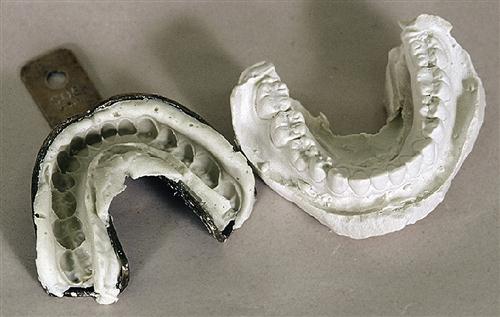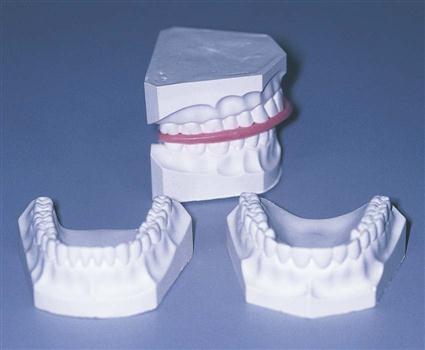Dental Models Are Poured Using Which of the Following Materials
The transfer impressions were made with custom trays and an irreversible hydrocolloid material and were poured with type IV gypsum. Learn vocabulary terms and more with flashcards games and other study tools.

12 Gypsum Materials Pocket Dentistry
Hydrocolloids can exist in a sol or a gel state.

. Mix the mixture of orthodontic plaster 50 stone. A ___ is a dental laboratory device that simulates the movement of the mandible and the temporomandibular joint when models of the dental arches are attached. -used for pouring preliminary impressions for diagnostic models or ortho.
Gypsum materials are used extensively to make casts and dies from dental impressions and can be used with any impression material. For impression material usage it comes in the form of. Common materials used for dental impressions are.
Custom trays are used to take final impressions for full dentures inlays crowns bridges and some removable partial dentures. Silicone impression material C. These casts are then used to treat dental problems.
Pour the alginate impressions with orthodontic plaster. An accurate water-to-powder ratio is a must to preserve the properties of any gypsum product. A model or cast material eg plaster of Paris or high-strength stone is poured into the impression and upon setting produces a positive impression of the tissues of interest.
Steps in pouring the study model. A ___ is a molecule that when combined with others forms a polymer. Classification of Elastomeric Impression materials.
Measure the volume of water and weigh the powder before you mix any gypsum material. Flow into the tooth portions from the palate in maxilla. ___ is a mixture of gypsum and water used in the finishing of models.
When the material can no longer be poured d. The device has the following parameters. -AKA plaster of paris white in color.
Department of Technology of Dental Materials and Devices in Dental Medicine Victor Babes University of Medicine and Pharmacy Timisoara Romania. Primary use of agar impression material. All impression materials must be in a plastic or fluid state while the replica is being made.
Materials Used To Create Dental Impressions The most widely used material is irreversible hydrocolloid especially for preliminary impressions. Metallic oxide paste B. The denture section of the model is cast by pouring a die stone such as calcium sulfate hemihydrate into the impression.
-requires greatest quantity of water for mixing and therefore is the weakest. Gypsum products are used mainly for positive reproductions or replicas of oral structures. The required type of material for taking an impression and the area that it covers will depend on the clinical indication.
Used mainly for making positive productions or replicas of oral structures often referred to as casts dies or models. It is a judgment call how much stone and water to use for pouring a model. These are basically synthetic rubber based materials which were initially called as Rubber Impression materials but currently they are known as Non aqueous Elastomeric Impression materials.
A preliminary impression or a dental impression is an imprint of the mouth hard and soft tissues from which casts are made. Mineral found in nature in various parts around the world known as calcium sulfate dihydrate and has been used in dentistry since 1756 for making castsdies. Use of Gypsum Products in Dentistry.
Till now the elastomeric impression materials are divided into 3 types based on the material used 1. Hygroscopic expansion is a useful characteristic of which of the following dental materials applications. Experts are tested by Chegg as specialists in their subject area.
The best time to clean a bowl and spatula is immediately after pouring the impression while the material is still soft and easy to remove. A gypsum product is poured into the impression and the resulting model is used to construct the custom tray. Flow into the tooth position from the posterior aspect and around the arch in mandible.
Polyether mercaptan-polysulfide addition silicone and condensation silicone. Dental stone is usually yellow It is stronger and harder than plaster Mostly used for products that require strength like retainers opposing models bite splints and removable Prosthodontics Model Stone 100g -- 30 to 32ml water Dental Plaster is white The least hard and weaker of the stones Its used for study models bleach trays. The impressions were obtained using the following materials.
We review their content and use your feedback to keep the quality high. A vinyl-polysiloxane silicone placed in a flask is used. 50 plaster of paris 2.
Gel in tubes tray material Number of cylinders in a glass jar or cartridges Syringe material 2. Keep adding water and mixing until stone is creamy like cake batter and holds its own weight on the spatula. Impression materials are used to make replicas of oral structures.
When the conversion of hemihydrate to dihydrate is. After its setting the duplicate model is poured using class IV hard plaster. Three forms of gypsum.
Which of the following model and die materials are derived from the mineral gypsum. Start studying Dental Materials Chapter 9. Continue to polymerise B.
Which material is the most difficult to remove from the patients mouth. Put large scoop of stone in a green mixing bowl and add water get powder wet start mixing slowly so powder does not get all over. The custom tray is then used to take a final impression.
A- Plaster study casts b- Densite models for dental implant restorations c- Fast-set plasters for mounting models to articulators d- Calcium sulfate-bonded casting investments. Gypsum products are supplied as fine powders that are mixed with water to form a fluid mass that can be poured and shaped and that subsequently hardens into a rigid stable mass. Away from patient care.
Show imbibition and syneresis D. It is used to make secondaryfinal impression in dentolous patients requiring removable and fixed partial dentures. Impression plaster Rubber base impression are poured immediately as they.
The die stone is then spatulated under vacuum with the aid of. Stone casts which are stronger and resist abrasion better than plaster casts are used whenever a restoration or appliance is to be made on the cast.

9 Model And Die Materials Pocket Dentistry

22 Impression Materials And Laboratory Procedures Pocket Dentistry


No comments for "Dental Models Are Poured Using Which of the Following Materials"
Post a Comment